Transportation in South Korea is provided by extensive networks of railways, highways, bus routes, ferry services and air routes that traverse the country. South Korea is the third country in the world to operate a maglev train, which is an automatically run people mover at Incheon International Airport.

Incheon, formerly Jemulpo or Chemulp'o (제물포) until the period after 1910, officially the Incheon Metropolitan City, is a city located in northwestern South Korea, bordering Seoul and Gyeonggi to the east. Inhabited since the Neolithic, Incheon was home to just 4,700 people when it became an international port in 1883. Today, about 3 million people live in the city, making it South Korea's third-most-populous city after Seoul and Busan.

Incheon International Airport (Korean: 인천국제공항) is the largest airport in South Korea. It is the primary airport serving the Seoul Capital Area and one of the largest and busiest airports in the world.

The Seoul Metropolitan Subway is a metropolitan railway system consisting of 23 rapid transit, light metro, commuter rail and people mover lines located in northwest South Korea. The system serves most of the Seoul Metropolitan Area including the Incheon metropolis and satellite cities in Gyeonggi province. Some regional lines in the network stretch out beyond the Seoul Metropolitan Area to rural areas in northern Chungnam province and western Gangwon province, that lie over 100 km (62 mi) away from the capital.

Gyeonggi Province is the most populous province in South Korea. Its name, Gyeonggi, means "京 and 畿 ". Thus, Gyeonggi-do can be translated as "Seoul and the surrounding areas of Seoul". Seoul, the nation's largest city and capital, is in the heart of the area but has been separately administered as a provincial-level special city since 1946. Incheon, the nation's third-largest city, is on the coast of the province and has been similarly administered as a provincial-level metropolitan city since 1981. The three jurisdictions are collectively referred to as Sudogwon and cover 11,730 km2 (4,530 sq mi), with a combined population of over 26 million - amounting to over half (50.25%) of the entire population of South Korea at the 2020 Census.
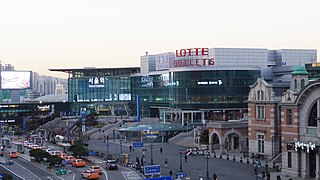
Seoul Station is a major railway station in Seoul, the capital of South Korea. The station is served by the Korail Intercity Lines and the commuter trains of the Seoul Metropolitan Subway.
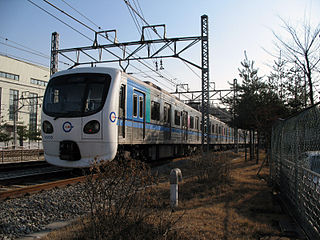
Incheon Subway Line 1 is a 29.4-kilometer (18.3 mi) north-south subway line, part of the Incheon Subway system. The line is also included as a part of the overall Seoul Metropolitan Subway network; Bupyeong Station has a free transfer with Seoul Subway Line 1, Gyeyang Station connects with the AREX Line which leads to Incheon International Airport and Seoul Station, Bupyeong-gu Office Station has a free transfer with Seoul Subway Line 7, and Woninjae Station has a free transfer with the Suin-Bundang Line.

Seoul Subway Line 9, operated by Seoul Line9 Operation, is a subway line in Seoul, part of the Seoul Metropolitan Subway. The line runs east from Gaehwa station or Gimpo International Airport station along the south bank of the Han River towards VHS Medical Center in Gangdong. In 2019, Line 9 has an annual ridership of 225 million or about 616,000 people per day.
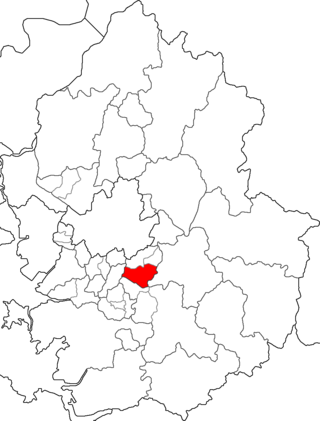
Bundang-gu is the largest and most populous district (gu) of Seongnam, a major city in the Seoul Capital Area, South Korea. Bundang-gu is one of South Korea's wealthiest and highest developed areas, being the nation's first and largest completely artificial city built in the early 1990s. Many high-rise luxury condos moved in the early 2000s, with a second planned city built in the late 2000s called Pangyo in the same district. Apartment prices are the second highest in Gyeonggi-do after Gwacheon and 7th highest nationwide, higher than many central Seoul districts such as Mapo-gu or Jongno-gu. Apartments around Pangyo station and the high-rise luxury condos around Jeongja station and Sunae station rival prices in the most expensive areas in the country. Unlike older cities such as Seoul, Bundang has no telephone poles overground, resulting in a clean cityscape with well-designed streets.

Songdo, officially known as Songdo International Business District (Songdo IBD), is a smart city built on 600 ha (1,500 acres) of reclaimed land along Incheon's waterfront, 30 km (19 mi) southwest of Seoul, South Korea. It is connected to Incheon International Airport by a 12.3 km (7.6 mi) reinforced concrete highway bridge called Incheon Bridge. Along with Yeongjong and Cheongna, it is part of the Incheon Free Economic Zone.

AREX is a South Korean airport rail link and commuter rail line that links Incheon International Airport with Seoul Station via Gimpo International Airport. The section between the two airports opened on March 23, 2007, and line was extended to Seoul Station on December 29, 2010. Long-distance Korea Train Express high speed trains started to use the line from June 30, 2014, but discontinued service in March 2018 due to low ridership.
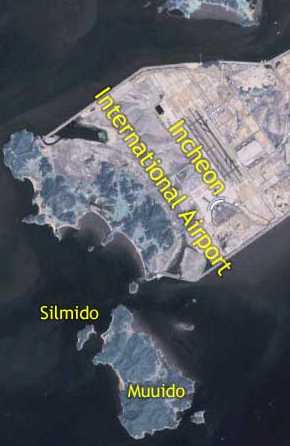
Muuido, also known as Muui Island, is an island in South Korea. It is a small island located south of Yongyu Island, which was joined with Yeongjong Island when Incheon International Airport was built. Muui Island measures 5.2 kilometres (3.2 mi) long and 4.5 kilometres (2.8 mi) wide. The island is visible from the airport.

Express Bus Terminal Station is a station on the Seoul Subway Line 3, Line 7, and Line 9. The stations are located in Banpo-dong, Seocho-gu, Seoul.

The Incheon Bridge is a reinforced concrete cable-stayed bridge in South Korea. At its opening in October 2009, it became the second bridge connection between Yeongjong Island and the mainland of Incheon. The Incheon Bridge is South Korea's longest spanning cable-stayed bridge. In comparison, it is the world's tenth longest cable-stayed bridge as of January 2019.
Seoul, the capital and largest city in South Korea, accounts for only 0.6% of the country's total land area, yet it is home to around 19% of the population. The population density in Seoul demands a great deal of the city's transportation systems, which are regarded by many as among the best and most advanced in the world. Seoul is very well connected by its subway and bus systems, and the city is also very supportive of pedestrian foot travel. In 2006 it won the Sustainable Transport Award.
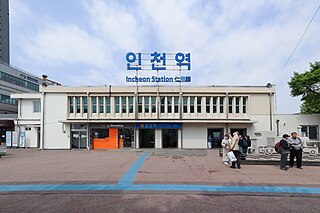
Incheon Station is the western terminus railway station of the Suin–Bundang and Gyeongin lines of the Seoul Metropolitan Subway. The station is in the Bukseong neighborhood of the Jung District in Incheon, South Korea and is approximately 20 kilometers west of Seoul. Established in 1899 under the Korean Empire as Chemulpo Station, Incheon Station is the oldest train station in the Seoul Capital Area. During the Japanese occupation of Korea, the station was briefly named Hainchon Station and the original station building was destroyed during the Korean War. Service for the Suin Line began in 1937 and ended in 1995. Service for the Gyeongjin Line began in 1974 and service on the Suin–Bundang Line began in 2020.
The Incheon Free Economic Zone (IFEZ), located in Incheon, South Korea is a Korean Free Economic Zone that consists of the three regions of Songdo, Cheongna, and the island of Yeongjong and has a total area of 51,739 acres (209.38 km2). The goal of the IFEZ is to transform these three areas into hubs for logistics, international business, leisure, and tourism for the Northeast Asian region. Incheon's Free Economic Zone was officially designated by the Korean government in August 2003. IFEZ is planned to be a self-contained living and business district featuring air and sea transportation, a logistics complex, an international business center, financial services, residences, schools and hospitals, and shopping and entertainment centres.
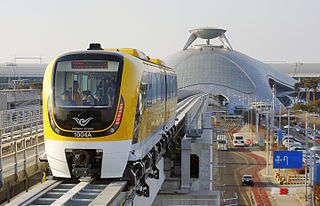
The Incheon Airport Maglev is a maglev line in South Korea opened on 3 February 2016. It is the world's second commercially operating unmanned urban maglev line after Japan's Linimo. The trains are lighter, cutting construction costs in half. The majority of construction was completed by November 2012.

The Seoul Capital Area (SCA), Sudogwon or Gyeonggi region, is the metropolitan area of Seoul, Incheon, and Gyeonggi Province, located in north-west South Korea. Its population of 26 million is ranked as the fourth largest metropolitan area in the world. Its area is about 12,685 km2 (4,898 sq mi). It forms the cultural, commercial, financial, industrial, and residential center of South Korea. The largest city is Seoul, with a population of approximately 10 million people, followed by Incheon, with 3 million inhabitants.

















